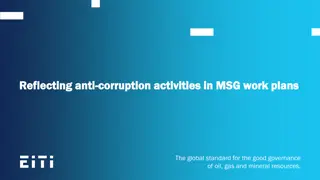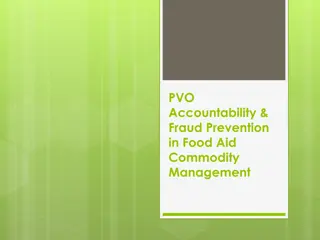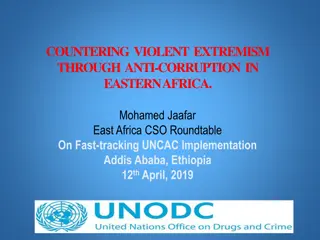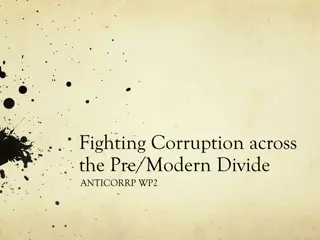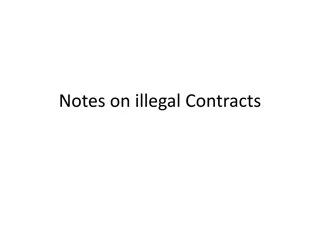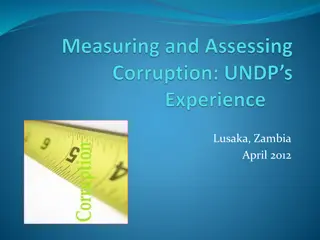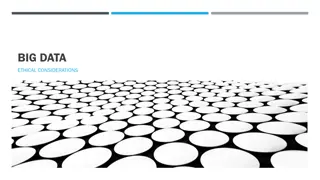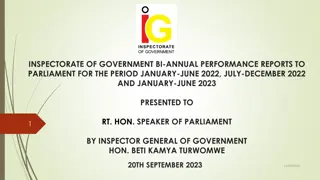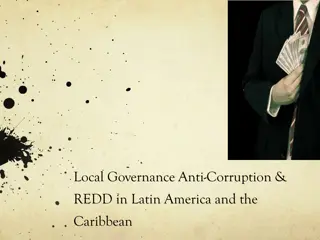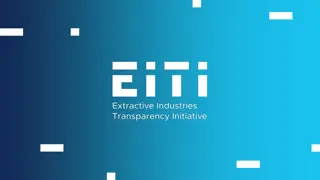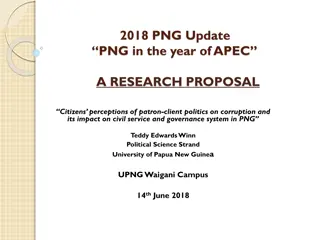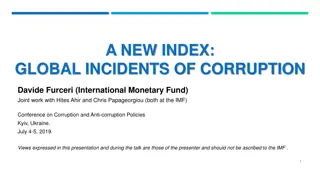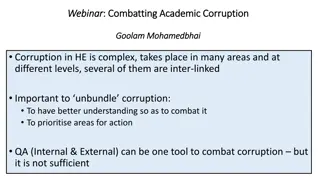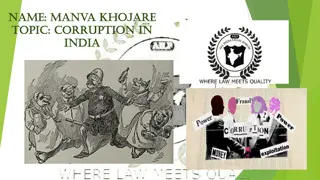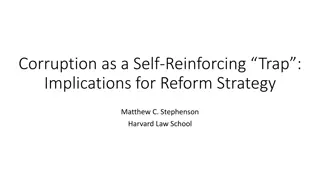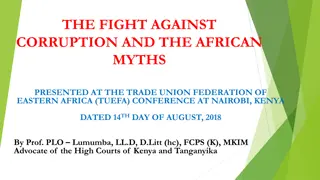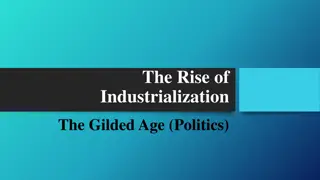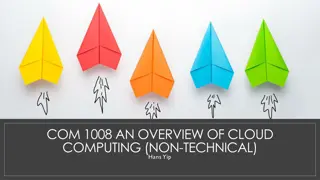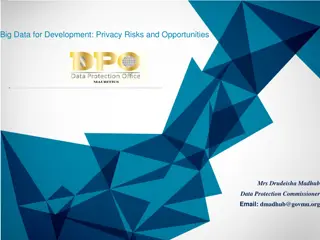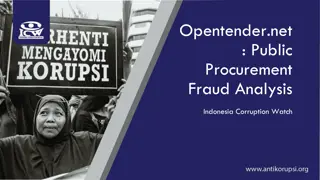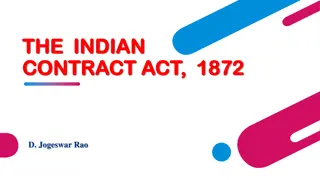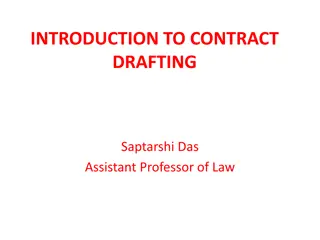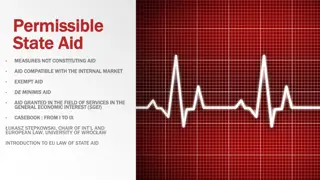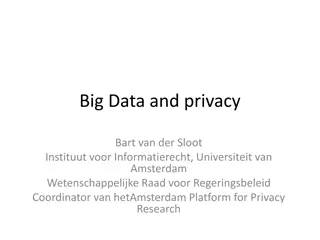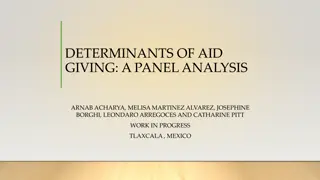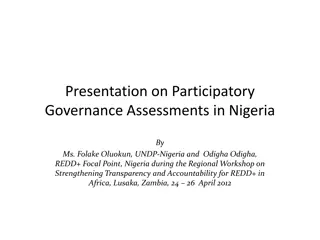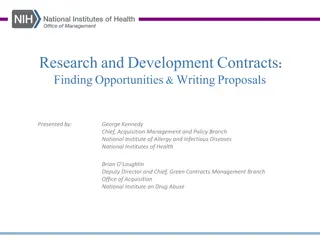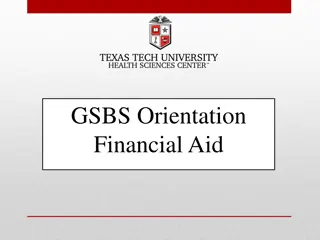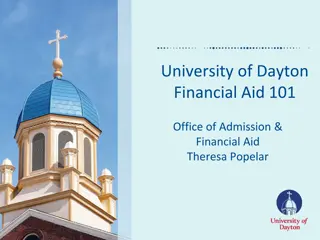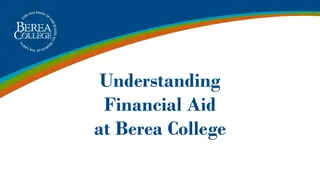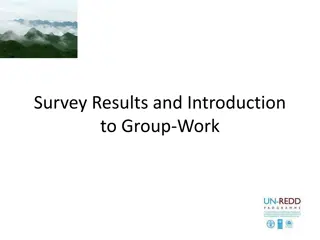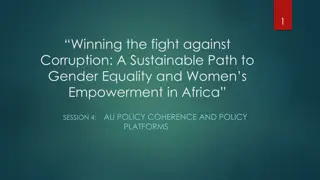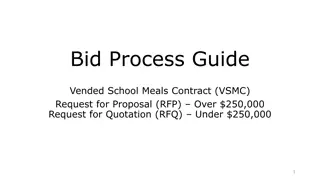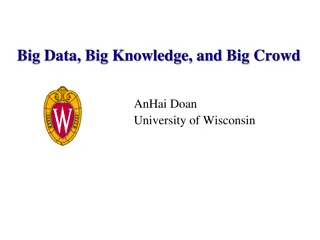Leveraging Big Data for Monitoring Corruption Risks in Development Aid Contracts
Explore insights on utilizing big data to enhance oversight and control corruption risks in development aid contracts, focusing on innovations in corruption measurement, data mobilization for development, and widening access to combat corruption. Understand corruption proxies, underlying data, and conceptualize public procurement corruption indicators. Discover the scope of IDB contracts and projects data and corruption risk indicators for effective monitoring.
Download Presentation

Please find below an Image/Link to download the presentation.
The content on the website is provided AS IS for your information and personal use only. It may not be sold, licensed, or shared on other websites without obtaining consent from the author. Download presentation by click this link. If you encounter any issues during the download, it is possible that the publisher has removed the file from their server.
E N D
Presentation Transcript
Mobilizing Big Data to control corruption risks in development aid contracts. Insights for IDB Mih ly Fazekas Central European University and Government Transparency Institute misi.fazekas@gmail.com Inter-American Development Bank, BBL, Washington DC, 29/8/2018 2024. 09. 30. 1
Three main topics 1. Recent innovations in corruption measurement Applicatons to IDB data 2. Data can be mobilized for development Currently available or easily acceible data can be used on the short term for monitoring and policy guidance 3. Widening access and increasing oversight Understanding corruption displacement effects 2024. 09. 30. 2
I. Corruption proxies & underlying data 2024. 09. 30. 3
Corruption definition In public procurement, the aim of corruption is to steer the contract to the favored bidder without detection. This is done in a number of ways, including: Avoiding competition through, e.g., unjustified sole sourcing or direct contract awards. Favoring a certain bidder by tailoring specifications, sharing inside information, etc. See: World Bank Integrity Presidency (2009) Fraud and Corruption. Awareness Handbook, World Bank, Washington DC. pp. 7. 2024. 09. 30. 4
Conceptualizing public procurement corruption indicators Tendering Risk Indicators (TRI) Contracting body Contract Supplier Particularistic tie Contracting Body Risk Indicators (CBRI) Supplier Risk Indicators (SRI) Political Connections Indicators (PCI) Source: Fazekas, M., Cingolani, L., & T th, B. (2016). A comprehensive review of objective September 30, 2024 corruption proxies in public procurement: risky actors, transactions, and vehicles of rent extraction: GTI-WP/2016:03. Government Transparency Institute. Budapest. 5
IDB: contracts & projects data Source (web scraping): http://www.iadb.org/en/projects/project- procurement,8148.html Scope of IDB contract awards dataset 2024. 09. 30. 6
Corruption risk indicators: IDB Time span macro validity micro validity Indicator Definition Level shortlist 1=non-open procedure types (DC,OTHER) 0=open procedure types (e.g. internat.comp.bidding) 1=consultancy procured 0=non-consultancy type product purchased 1=Foreign supplier registered in a tax haven 0=Foreign supplier registered in non-tax haven (or Domestic supplier) Tender (goods& works) 1991- 2016 Non-open procedures No Low 1991- 2016 Spending on consultancy Tender High Moderate x 1991- 2016 Supplier tax haven registration Tender High Moderate x sum of contract awards amount / total project cost 1991- 2016 Low - Moderate Share of published contract awards Project Moderate x 1991- 2016 Agency/supplier capture spending share of largest supplier/buyer Tender na na
Macro validity WGI-Control of Corruption vs supplier tax haven registration (2015, IDB financed contracts) 2024. 09. 30. 8
Agency capture Distribution of buyers awardig IDB financed contracts according to max spending share of dominant supplier (annual, 10+ contracts) BUT, need for organisation name cleaning 4000 3000 Frequency 2000 1000 0 2024. 09. 30. 9 0 .2 By ANB-year: Max share spent on one winner .4 .6 .8 1
I. Corruption proxies & underlying data: European examples 2024. 09. 30. 10
Lack of competition ~ single bidding (on national competitive markets) Single bidding correlates with subjective indicators of corruption 2024. 09. 30. 11
Modelling corrupt contracting: single bidding Distribution of contracts according to the advertisement period Tight deadline Probability of single bid submitted for contracts compared with the market norm of 48+ days Single bidding Source: EU s Tenders Electronic Daily (TED), Portugal , 2009-2014 2024. 09. 30. 12
SRI: Expected success of companies by age 1. Gradual build-up of contracts 2. Natural fluctuation over time 2024. 09. 30. 13
SRI: Observed success of companies at specific ages 1. Just founded companies 2. Companies founded under party last in power Hungary, 2010 Source: Fazekas, M., Luk cs, P. A., & T th, I. J. (2015). The Political Economy of Grand Corruption in Public Procurement 2024. 09. 30. in the Construction Sector of Hungary. In A. Mungiu-Pippidi (Ed.), Government Favouritism in Europe. The Anticorruption Report 3 (pp. 53 68). Berlin: Barbara Budrich Publishers. 14
Clusters of risk: young firms Source: Fazekas, Mih ly , & T th, Bence, (2017), Proxy indicators for the corrupt misuse of corporations. U4 Brief. October 2017:6. U4 - 2024. 09. 30. Chr. Michelsen Institute, Bergen, Norway. 15
SRI: Politically driven company success: Hungary a paradigmatic case Companies lose/win surprisingly when government changes Hungary, 2009-2012 Surprise success goes together with procurement red flags (CRI) Source: D vid-Barrett, Elizabeth and Fazekas, Mih ly, (2016). Corrupt Contracting: Partisan Favouritism in Public Procurement. GTI- WP/2016:02, Budapest: Government 2024. 09. 30. 16 Transparency Institute.
SRI: Politically driven company success: UK exception to the rule Few companies lose/win surprisingly when government changes UK, 2009-2012 Surprise success sometimes goes together with procurement red flags (CRI) Source: D vid-Barrett, Elizabeth and Fazekas, Mih ly, (2016). Corrupt Contracting: Partisan Favouritism in Public Procurement. GTI- WP/2016:02, Budapest: Government 2024. 09. 30. 17 Transparency Institute.
Variable group Variable Buyer s name Buyer s unique ID Buyer s address Bidder s name Bidder s unique ID/tax ID Bidder s address Number of bids submitted Number of bids excluded Bid price (details on total and unit prices) Exact time of bid submission Bid type (winner/loser bid) Beneficial owners Procedure type Framework agreement (1st/2ndstage) Estimated price (details on total or unit prices) Procurement type (service, supply, work) CPV codes (by product type weight) NUTS code(s) of contract implementation Status (cancelled, pending, etc.) Call for tender publication date Bid submission deadline Contract start and end dates Publication date of contract award Date of contract completion SubcontractingSubcontractor s name and unique ID (tax ID) Subcontractor s share Consortium Consortium members share Contract performance end date Was performance according to the contract Explanation in case of deferring from contract Information on contract modification Information on performance quality Minimum data scope for a corruption& collusion risk assessment Buyer Bidder / bids Tender / contract See: https://opentender.eu/ blog/2017-03-towards- more-transparency/ Dates Consortium members name and unique ID (tax ID) Contract performance September 30, 2024 18
Open data available: DIGIWHIST, BA/DFID & beyond Unprecedented open data available! Full European data&indicators on DIGIWHIST watchdog portals: https://opentender.eu 17.5 million contracts, 32 countries+EC 1. 2. Development aid funded procurement+selected developing countries: World Bank, IDB, Europeaid + Tanzanian national data (www.govtransparency.eu/index.php/category/databases 3. Approach scaleable and standardized: ongoing work in Selected developing countries national data: Brazil, Chile, Columbia, India, Indonesia, Jamaica, Mexico, Paraguay, South Africa , Uganda Selected developed countries: US(federal contracting) If you are interested, get in touch, happy to share data and collaborate! 2024. 09. 30. 19
II. Risk management tools 2024. 09. 30. 20
Using data for corruption prevention 1. Risk assessment: Mezo-level (e.g. sectoral, regional) Counterpart-level Project/tender-level 2. Policy advice: e.g. identifying vulnerabilities&trends 3. Automatic compliance checks: e.g. applying procurement rules 2017.09.14. 21
Sectoral risk scoring: infrastructure subsectors Source: Fazekas, M. & T th, B. (2017), Infrastructure for whom? Corruption risks in 2024. 09. 30. infrastructure provision across Europe. In Hammerschmid, G, Kostka, G. & Wegrich, K. (Eds.), The Governance Report 2016. Oxford University Press, ch 11. 22
Corruption risks in infrastructure spending by region Some regions in otherwise low corruption risk countries carry high risks 2024. 09. 30. Source: Fazekas, M. & T th, B. (2017), Infrastructure for whom? Corruption risks in infrastructure provision across Europe. In Hammerschmid, G, Kostka, G. & Wegrich, K. (Eds.), The Governance Report 2016. Oxford University Press, ch 11. 23
Organisational risk scoring: EIB example EIB counterpart avg. organisational risk scores General PP behavior ~ Eib funded procurement behavior 250,000+ tenders, 10 tailored red flags 80 60 Frequency 40 20 0 0 .2 .4 .6 .8 2024. 09. 30. 24 (mean) cri_eib
Corruption & overpriced projects Source: Fazekas, M. & T th, B. (2017), Infrastructure for whom? Corruption risks in infrastructure provision across Europe. In Hammerschmid, G, Kostka, G. & Wegrich, K. (Eds.), The Governance Report 2016. 2024. 09. 30. Oxford University Press, ch 11. 25
Corruption and road prices Source: Fazekas, M. & T th, B. (2017), Infrastructure for whom? Corruption risks in 2024. 09. 30. infrastructure provision across Europe. In Hammerschmid, G, Kostka, G. & Wegrich, K. (Eds.), The Governance Report 2016. Oxford University Press, ch 11. 26
Complex risk scoring: Corruption risks cluster in contracting networks Considerable clustering of risks buyer-supplier bimodal network N org. contract >=5 or <=50 2017.09.14. 27
Policy evaluation: Evaluating World Bank: 2003 GWS procurement rule change Interaction of regulatory change & recipient state capacity to predict bidder number Source: D vid-Barrett, E., Fazekas, M., Hellmann, O., M rk, L. & McCorley C. (2017) Controlling Corruption in Development Aid: 2017.09.14. New Evidence from Contract-Level Data. World Development, under review. 28
Quality of governance change over time i) ii) 100 12 average announcement completeness average bidder number (trimmed) 95 10 90 8 85 6 80 4 2006 2007 2008 2009 2010 2011 2012 2013 2014 2015 2006 2007 2008 2009 2010 2011 2012 2013 2014 2015 year year Continental Western Europe Scandinavia Mediterranean Europe Anglo-Saxon Central and Eastern Europe Continental Western Europe Scandinavia Mediterranean Europe Anglo-Saxon Central and Eastern Europe iii) iv) 20 30 15 Source: Fazekas, Mih ly, (2017): Assessing the Quality of Government at the average savings rate single bidding 20 2024. 09. 30. 10 Regional Level Using Public Procurement Data. WP 12/2017, Brussels: European Commission, Directorate-General for Regional Policy. 29 10 5 0 0 2006 2007 2008 2009 2010 2011 2012 2013 2014 2015 2006 2007 2008 2009 2010 2011 2012 2013 2014 2015 year year Continental Western Europe Scandinavia Mediterranean Europe Anglo-Saxon Central and Eastern Europe Continental Western Europe Scandinavia Mediterranean Europe Anglo-Saxon Central and Eastern Europe
Tracking change over time: Changing composition of foreign suppliers? Home region of suppliers to Swedish buyers 2017.09.14. Source: DIGIWHIST @ opentender.eu/se 30
Automatic compliance checks: Misplaced tenders: avoiding TED Number of contracts around the EU publication threshold Services, central government, Poland 600 450 Number of tenders 300 150 0 -100000 -50000 0 50000 100000 Estimated tender value from national database from TED Source: T th, B., Fazekas, M. (2017): Compliance and strategic contract manipulation around single market regulatory thresholds the case of Poland. GTI-WP/2017:01, Budapest: Government Transparency Institute. See: http://www.govtransparency.eu/index.php/2017/08/28/compliance-and-strategic-contract-manipulation-around-single-market-regulatory- thresholds-the-case-of-poland/ 31
Potential contract slicing Number of tenders around the EU publication threshold in 2010-2011 (left) and 2012-2013 (right) Services, local government, Poland 1000 800 800 600 Number of tenders Number of tenders 600 400 400 200 200 0 0 100000 150000 200000 250000 300000 100000 150000 200000 250000 300000 Tender value Tender value Source: T th, B., Fazekas, M. (2017): Compliance and strategic contract manipulation around single market regulatory thresholds the case of Poland. GTI-WP/2017:01, Budapest: Government Transparency Institute. See: http://www.govtransparency.eu/index.php/2017/08/28/compliance-and-strategic-contract-manipulation-around-single-market-regulatory- thresholds-the-case-of-poland/ 32
Does gaming matter? Ratio of single bidder contracts around the EU threshold (2010- 2015) local authorities, services, Poland 0.9 0.7 Mean of singleb 0.5 0.3 0.1 -40000 -20000 0 20000 40000 estorfin_value_distance_ext_alt Source: T th, B., Fazekas, M. (2017): Compliance and strategic contract manipulation around single market regulatory thresholds the case of Poland. GTI-WP/2017:01, Budapest: Government Transparency Institute. See: http://www.govtransparency.eu/index.php/2017/08/28/compliance-and-strategic-contract-manipulation-around-single-market-regulatory- thresholds-the-case-of-poland/ 33
3 options for tapping into Big Data analytics 1. Use existing national systems: many countries have sufficient national data (LINKING!) Can get started tomorrow 2. Invest into national systems: e.g. WB s work in Bangladesh Mid-term solution: 2-3 years until data is ready 3. Build a central PP system WB is doing that and it is hard 2024. 09. 30. 34
LAC national public procurement landscape Publicly available, sufficeint quality datasets already collected (or close to it): 1. Brazil (federal) 2. Chile 3. Columbia 4. Jamaica 5. Mexico 6. Paraguay Good enough quality national PP data for risk assessment (as I know) 1. Brazil (selected states) 2. Costa Rica 3. Ecuador 4. Peru 5. Uruguay 2024. 09. 30. 35
What is possible on the short term: e.g. Paraguay public data Explorative analysis using public data: understanding the local context Comparing spending concentration of procuring entities which received/managed or not IDB funds (10+ contracts awarded per year) 0 1 20 15 Percent 10 5 0 0 .5 1 0 .5 1 By PA-year: Max share spent on one supplier 2024. 09. 30. 36 Graphs by idb_shbi
III. Reducing rather than displacing corruption in development aid 2024. 09. 30. 37
Motivation The typical anticorruption intervention is small-scale prone to evasion and strategic response Rise of focused anti-corruption impact evaluations and feeding scientific findings into policy Measuring unintended consequences and displacement effects entered center stage recently High-level, organised corruption is particularly prone to strategic adaptation
Main research question Do donor reforms aiming to open up competition lower corruptions risks or merely displace them?
Hypotheses H1: Increased donor oversight and wider access to aid-funded public procurement decrease corruption risks associated with lack of competition. H2: Increased donor oversight and wider access to aid-funded public procurement displace corruption risks to less competitive procedure types and higher risk contract signature. H3: Increased donor oversight and wider access to aid-funded public procurement increase corruption risks in already risky non- competitive procedure types. H4: Increased donor oversight and wider access to aid-funded public procurement expand participation of less connected (foreign) bidders at the expense of more connected (domestic) bidders.
Data, intervention and causal identification Data: Project finance to governments (no budget support, no grants to NGOs/private sector), World Bank prior reviewed tenders, goods & works, 2000- 2008, contracts above 25K USD Intervention: World Bank changes in public procurement rules for Goods and Works in November 2003 -Same rules, different contexts -Most significant changes: -Donor oversight: e.g. intro of procurement plans, extension of audits to Number of contracts awarded in the treated and control groups bidders (not just winners) -Tender advertisement: wider use of electronic advertisement -E-procurement -Project-level rule implementation tight contract level matching 2000 2001 2002 2003 2004 2005 2006 2007 2008 Total Control 1,307 2,434 3,572 4,062 4,060 3,432 2,160 1,505 690 23,222 Treated 0 0 0 0 319 1,133 1,496 1,601 1,047 5,596 Total 1,307 2,434 3,572 4,062 4,379 4,565 3,656 3,106 1,737 28,818
Indicators Tendering phase Bidding Indicator name Indicator definition Non-competitive procedure type 1=non-open procedure types (e.g. single source) 0=open procedure types competitive bidding) (e.g. international Different phases of the procurement process allow for different ways of stealing from aid contracts Single bid 1=1 bidder per contract 0=2 or more bidders per contract Bidder (trimmed)* Repeat winner number Bidder number (50+ bidders set at 50) Contract award 1=supplier won at least 2 contracts in 1998-2014 0=supplier won only 1 contract in 1998-2014 Foreign supplier* 1=supplier is registered in a foreign country 0=supplier is registered in the country of buyer Risky period signature 1=Time signature date is shorter than 14 days 0=Time between signature date is longer than 14 days between award date and contract Contract signature award date and contract
Results: full sample bidder number (trimmed) 4.50 5.04 0.54* 0.12 0.95 1,404 1,404 closed procedure type 7.3% 9.6% 2.3%* 1.4% 3.2% 7,515 7,515 risky signature period 25.0% 29.4% 4.5* 3.0% 5.9% 7,515 7,515 repeat winner foreign supplier single bid control treatment diff(treatment - control) 95% c.interval-lower bound 95% c.interval-upper bound N control N treatment matching variables log contract value main sector year dummies country prior DV avg. buyer prior DV avg. * 5% significance level 22.4% 18.7% -3.8%* -6.8% -0.8% 1,404 1,404 71.8% 65.4% -6.4% -7.9% -5.0% 7,515 7,515 15.8% 13.7% -2.0%* -3.1% -0.9% 7,515 7,515 Y Y Y Y Y Y Y Y Y Y Y Y Y Y Y Y Y Y Y Y Y Y Y Y Y Y Y Y Y Y
Results: competitive procedures bidder number (trimmed) risky signature period repeat winner foreign supplier single bid control treatment diff(treatment - control) 95% c.interval-lower bound 95% c.interval-upper bound N control N treatment matching variables log contract value main sector year dummies country prior DV avg. buyer prior DV avg. * 5% significance level 18.5% 10.0% -8.5%* -11.2% -5.8% 1,235 1,235 4.60 5.52 0.92* 0.46 1.39 1,237 1,237 24.1% 28.5% 4.4%* 2.9% 5.9% 6,966 6,966 72.5% 64.5% -8.0%* -9.5% -6.5% 6,966 6,966 14.6% 13.6% -1.1% -2.2% 0.1% 6,966 6,966 Y Y Y Y Y Y Y Y Y Y Y Y Y Y Y Y Y Y Y Y Y Y Y Y Y
Results: non-competitive procedures bidder number (trimmed) risky signature period repeat winner foreign supplier single bid control treatment diff(treatment - control) 95% c.interval-lower bound 95% c.interval-upper bound N control N treatment matching variables log contract value main sector year dummies country prior DV avg. buyer prior DV avg. * 5% significance level 67.3% 81.0% 13.7%* 4.4% 23.0% 1,235 1,235 1.70 1.43 -0.27* -0.51 -0.03 1,237 1,237 36.8% 41.3% 4.6% -1.2% 10.3% 6,966 6,966 63.2% 58.5% -4.7% -10.5% 1.0% 6,966 6,966 29.9% 20.9% -8.9%* -14.1% -3.8% 6,966 6,966 Y Y Y Y Y Y Y Y Y Y Y Y Y Y Y Y Y Y Y Y Y Y Y Y Y
Conclusions Sizeable strategic responses mitigating overall positive effects H1: Single bidding: 22%->19% H1: Repeat winner: 72%->65% H2: Closed procedures: 7%->10% H2: Risky signature period: 25%->29% H3: Competitive procedures: more competition; non-competitive procedures: less competition (single bidder % gap 49%->71%) H4: Foreign winner: 16%->14% Net welfare effect: Zero? Negative?
Further readings: digiwhist.eu/resources Fazekas, M., & Kocsis, G. (2017). Uncovering High-Level Corruption: Cross-National Corruption Proxies Using Government Contracting Data. British Journal of Political Science, available online. Fazekas, Mih ly, (2017): Assessing the Quality of Government at the Regional Level Using Public Procurement Data. WP 12/2017, Brussels: European Commission, Directorate-General for Regional Policy. D vid-Barrett, Elizabeth, Fazekas, Mih ly, Hellmann, Olli, M rk, Lili, & McCorley, Ciara, (2017): Controlling Corruption in Development Aid: New Evidence from Contract- Level Data. SCSC Working Paper No. 1. Sussex Centre for the Study of Corruption, University of Sussex. T th, B., Fazekas, M. (2017): Compliance and strategic contract manipulation around single market regulatory thresholds the case of Poland. GTI-WP/2017:01, Budapest: Government Transparency Institute. Fazekas, Mih ly , & T th, Bence, (2017), Proxy indicators for the corrupt misuse of corporations. U4 Brief. October 2017:6. U4 - Chr. Michelsen Institute, Bergen, Norway Fazekas, M. & T th, B. (2017), Infrastructure for whom? Corruption risks in infrastructure provision across Europe. In Hammerschmid, G, Kostka, G. & Wegrich, K. (Eds.), The Governance Report 2016. Oxford University Press, ch 11. Fazekas, M., Cingolani, L., & T th, B. (2016). A comprehensive review of objective corruption proxies in public procurement: risky actors, transactions, and vehicles of rent extraction: GTI-WP/2016:03. Government Transparency Institute. Budapest. Fazekas, M. and T th, I. J. (2016). From corruption to state capture: A new analytical framework with empirical applications from Hungary. Political Research Quarterly, 69(2). D vid-Barrett, Elizabeth and Fazekas, Mih ly, (2016). Corrupt Contracting: Partisan Favouritism in Public Procurement. GTI-WP/2016:02, Budapest: Government 2017.09.14. Transparency Institute. 47


